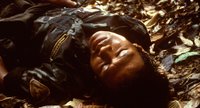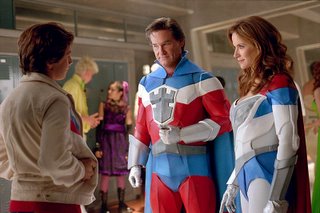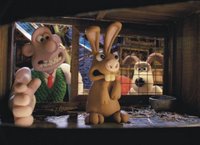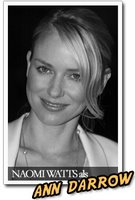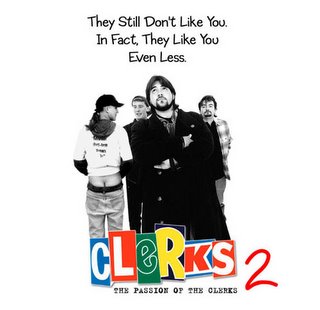GOOD NIGHT, AND GOOD LUCK: 11th-HOUR OSCAR NOMINATION PREDICTIONS
UPDATED 1/31/06 12:19pm: Blaaagh has noted that I left Adam Baldwin off my list of pleasurable performances for his work in Serenity. That oversight has been corrected...
UPDATED 1/31/06 9:42 am: Click on the link to see how my Oscar guesses matched up with the actual list.
 As I begin writing this post, we're about eight hours away from the announcement of the nominations for the 78th annual Academy Awards. In the days before the dawning of the age of the Internet, I would probably be in bed by now. Because back then I actually had to get up-- actually looked forward to getting up-- at 5:30 a.m. to watch on TV as the nominations were announced by the likes of Arthur Hiller or Frank Pierson or Robert Rehme and whoever it was that won the Best Supporting Actress the previous year (this year, Mighty Aphrodite herself, Mira Sorvino, returns, accompanied by current AMPAS president Sid Ganis). I'd then have to wait until a late edition of something called a newspaper, or perhaps even the next morning's early edition, before a list of the nominations would be available, and then only major papers like the Los Angeles Times, The New York Times or one of the trade papers, like The Hollywood Reporter could be relied upon to provide an accurate and truly complete list.
As I begin writing this post, we're about eight hours away from the announcement of the nominations for the 78th annual Academy Awards. In the days before the dawning of the age of the Internet, I would probably be in bed by now. Because back then I actually had to get up-- actually looked forward to getting up-- at 5:30 a.m. to watch on TV as the nominations were announced by the likes of Arthur Hiller or Frank Pierson or Robert Rehme and whoever it was that won the Best Supporting Actress the previous year (this year, Mighty Aphrodite herself, Mira Sorvino, returns, accompanied by current AMPAS president Sid Ganis). I'd then have to wait until a late edition of something called a newspaper, or perhaps even the next morning's early edition, before a list of the nominations would be available, and then only major papers like the Los Angeles Times, The New York Times or one of the trade papers, like The Hollywood Reporter could be relied upon to provide an accurate and truly complete list.Of course, in these more enlightened times (and in case the link didn't completely sell it, I was trying to be ironic), the Internet provides instant access to the complete roster of nominees straight from Oscar's mouth. So, alas, no more need to get up even earlier than my rambunctious daughters just to hear the vaunted press gasp and applaud, as if they never would have guessed they'd have heard it, when Heath Ledger's name is announced. And oh, how I'll miss hearing breathless junket whore Sam Rubin and whoever KTLA has chosen to chirp alongside him as they ramble on and on about their own knee-jerk reactions to those who made the final five and those who did not, warming up for when they can really cut loose and embarrass themselves properly on the red carpet during the Oscar pre-show, and filling precious pre-dawn minutes that could instead be devoted to agricultural reports and who's coming to visit Aunt Tillie on the farm in Santa Monica this weekend. But maybe, just maybe, I won't even think about all this tomorrow morning, as I luxuriate in the precious couple of hours of sleep I would have lost had I gotten up to catch the Oscar nominations the old skool way.
So instead, I thought I'd make some 11th-hour predictions for the acting and directing categories, based on nothing so scientific or inside as the methods undoubtedly employed by Entertainment Weekly as they have methodically pored over and updated their own predictions leading up to tomorrow morning. (I'm pretty sure these pop culture gatekeepers started predicting this year's winners sometime mid-Governor's Ball, just after the conclusion of last year's ceremony.) No, where EW has computers and panels of experts and reams of insider information, I have only my own (quite prodigious) gut to rely upon. This year's abdominal resonations have been a whole lot less distinct than ever before, owing to the fact that the crop of movies undoubtedly waiting to be lionized by the Academy this year hold much less interest for me as a whole-- A History of Violence is likely to have minimal representation among the nominees, but I'm not holding my breath in anticipation of anyone from 2046, Kung Fu Hustle, Grizzly Man or The Ice Harvest making waves tomorrow morning (King Kong will make its roar known, but only from the back of the room, where the Academy sticks all the technical award nominees.) And the one movie that I admire almost without reservation-- Good Night, and Good Luck, which I finally saw this past Friday night, and which I would retroactively place fourth on my Top 22 list-- will surely be nominated, but will likely end up the most recognizable body crushed under the speeding locomotive that is Brokeback Mountain. Where Brokeback looks weakest is, ironically, in its most high-profile category-- Best Actor. Until this past weekend, I would have be the sheep herd on Heath Ledger's chances to go all the way to the podium. But given the way the Screen Actors Guild awards shook out this past weekend-- no love for Ledger, much love for Philip Seymour Hoffman's portrayal of Truman Capote-- I have a feeling either Hoffman's Oscar's man this year or, in a situation where Ledger and Hoffman split off enough votes, David Straithairn, unflappable and awesome (in an admittedly less complex role than either of the other two) as Edward. R. Murrow, might be the beneficiary of some Oscar glory.
Here I am talking like I already know who's nominated and, of course, I don't. But I am willing to step out, risk looking stupid, and perhaps even fatally damage my street cred with the Access Hollywood crowd by taking a series of ridiculous wild guesses in these final hours. So, without any further fuss and muss, here's where I pin the donkey's tail on the six picture, actor, actress and director categories before the 78th Academy Award nominations are announced tomorrow morning.
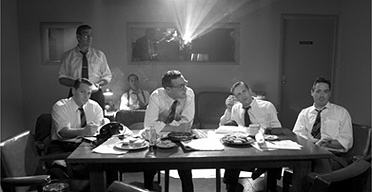
BEST PICTURE
Brokeback Mountain
Capote
Crash
Good Night, and Good Luck
Munich

BEST DIRECTOR
George Clooney, Good Night, and Good Luck
Ang Lee, Brokeback Mountain
Paul Haggis, Crash
Terence Malick, The New World
Bennett Miller, Capote

BEST ACTRESS
Dame Judi Dench, Mrs. Henderson Presents
Felicity Huffman, Transamerica
Keira Knightley, Pride and Prejudice
Naomi Watts, King Kong
Reese Witherspoon, Walk the Line

BEST ACTOR
Philip Seymour Hoffman, Capote
Terrence Howard, Hustle and Flow
Heath Ledger, Brokeback Mountain
Joaquin Phoenix, Walk the Line
David Straithairn, Good Night, and Good Luck

BEST SUPPORTING ACTRESS
Maria Bello, A History of Violence
Diane Keaton, The Family Stone
Catherine Keener, Capote
Rachel Weisz, The Constant Gardener
Michelle Williams, Brokeback Mountain

BEST SUPPORTING ACTOR
George Clooney, Syriana
Paul Giamatti, Cinderella Man
Matt Dillon, Crash
Terrence Howard, Crash
Donald Sutherland, Pride and Prejudice
*******************************************
Okay, now that that filthy business has been taken care of, it's time to invoke the spirit of Siskbert and revisit those same categories, only inserting the names of the pictures, actors, actresses and directors I would include If Only I Nominated the Academy Awards...

BEST PICTURE*
2046
A History of Violence
Good Night, and Good Luck
Kung Fu Hustle
The Ice Harvest
* I have bound myself by Academy rules and included only those movies that could actually be nominated in the respective categories. Therefore Los Angeles Plays Itself, number two on my year-end list, would not receive a nomination because it never received an official release, either last year or any year since its copyrighted date of 2003; also, Grizzly Man, number five on my list, would be in my hypothetical Best Documentary category, Tropical Malady-- retroactively, #6-- would be in the Best Foreign Film category, and Wallace & Gromit and the Curse of the Were-rabbit (the actual #6) would head up the short roster in the Best Animated Film category.

BEST ACTRESS
Kate Dollenmayer, Funny Ha-Ha
Rachel McAdams, Red Eye
Naomi Watts, King Kong
Reese Witherspoon Walk the Line
Ziyi Zhang, 2046

BEST ACTOR
Johnny Depp, Charlie and the Chocolate Factory
Min-sik Choi, Oldboy
Philip Seymour Hoffman, Capote
Viggo Mortenson, A History of Violence
David Straithairn, Good Night, and Good Luck

BEST SUPPORTING ACTRESS
Maria Bello, A History of Violence
Kerry Condon, Unleashed
Catherine Keener, Capote
Gena Rowlands, The Skeleton Key
Faye Wong, 2046
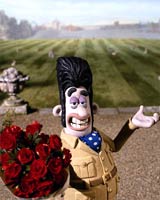
BEST SUPPORTING ACTOR
Clifton Collins, Jr., Capote
Ralph Fiennes, Wallace & Gromit and the Curse of the Were-rabbit
Oliver Platt, The Ice Harvest
Andy Serkis, King Kong
Mathieu Amalric, Munich

BEST DIRECTOR
Stephen Chow, Kung Fu Hustle
George Clooney, Good Night, and Good Luck
David Cronenberg, A History of Violence
Werner Herzog, Grizzly Man
Wong Kar Wai, 2046
And now finally, in the waning hours before there is instituted an official embargo on talk of anything released in 2005 that is not on the Academy's invite card to the Kodak Theater, I just wanted to take a moment to remember one last time the names of the actors, some renowned, some unknown, who gave me pleasure at the cinema in the past year. These were almost all folks who stood not a chance in hell of being recognized by such an august body as the Academy, yet the moments and performances they gave to me, to us, last year were every bit as good and fully rounded and lived-in and exciting, sometimes even more so, than the ones given by the nominees whose names will be announced in about five and a half hours. They were (in no appreciable order whatsoever):
Tony Leung, Gong Li 2046
Ed Harris, Asthon Holmes, William Hurt, A History of Violence
George Clooney, Frank Langella, Ray Wise, Good Night, and Good Luck
Stephen Chow, Kwok Kuen Chen, Qui Yuen, Siu-Lung Leung, Zhi Hua Dong, Kung Fu Hustle
Helena Bonham Carter, Peter Sallis and the entire voice cast of Wallace & Gromit and the Curse of the Were-rabbit
Banlop Lomnoi, Sakda Kaewbuadee, Tropical Malady
John Cusack, T.J. Jagodowski, Connie Nielsen, Bill Noble, Randy Quaid, Mike Starr, Billy Bob Thornton, The Ice Harvest
Jack Black, Adrian Brody, Thomas Kretschmann, King Kong
Andrew Bujalski, Funny Ha-Ha
Brady Corbet, Joseph Gordon-Leavitt, Mysterious Skin
Eric Bana, Lynn Cohen, Daniel Craig, Ciaran Hinds, Mathieu Kassovitz, Geoffrey Rush, Ayelet Zorer, Munich
Morgan Freeman, Bob Hoskins, Jet Li, Unleashed
Bradley Cooper, Rebecca De Mornay, Isla Fisher, Henry Gibson, Rachel McAdams, Vince Vaughn, Christopher Walken, Owen Wilson, Dwight Yoakam, Wedding Crashers
Elizabeth Banks, Gerry Bednob, Steve Carell, Catherine Keener, Kat Dennings, Jane Lynch, Romany Malco, Shelley Malil, Leslie Mann, Seth Rogen, Paul Rudd, The 40-Year-Old Virgin
Christian Bale, Michael Caine, Morgan Freeman, Rutger Hauer, Katie Holmes, Gus Lewis, Cillian Murphy, Liam Neeson, Gary Oldman, Linus Roache, Ken Watanabe, Tom Wilkinson, Batman Begins
Hank Azaria, Shelley Berman, Mario Cantone, George Carlin, Pat Cooper, Wayne Cotter, Phyllis Diller, Susie Essman, Carrie Fisher, Gilbert Gottfried, Dana Gould, Dom Irrera, Paul Krassner, Cathy Ladman, Merrill Markoe, Michael McKean, Martin Mull, Taylor Negron, Trey Parker, Don Rickles, Bob Saget, Sarah Silverman, Matt Stone, larry Storch, The Aristocrats
Jayma Mays, Cillian Murphy, Red Eye
Helena Bonham Carter, James Fox, David Kelly, Freddie Highmore, Christopher Lee, Missi Pyle, Deep Roy, Noah Taylor, Philip Wiegratz, Charlie and the Chocolate Factory
Ginnifer Goodwin, Shelby Lynne, Robert Patrick, Joaquin Phoenix, Dallas Roberts, Walk the Line
Ralph Fiennes, Danny Huston, Bill Nighy, Gerard McSorley, Rachel Weisz, The Constant Gardener
Morena Bacarrin, Adam Baldwin, Chiwetel Ejiofor, Nathan Fillion, Ron Glass, Summer Glau, Jewel Staite, Alan Tudyk, Serenity
Micahel Angarano, Bruce Campbell, Dave Foley, Cloris Leachman, Kevin MacDonald, Danielle Panabaker, Kelly Preston, Kurt Russell, Steven Strait, Kelly Vitz, Mary Elizabeth Winstead, Sky High
Tobin Bell, Glenn Plummer, Shawnee Smith, Mark Wahlberg, Saw II
Nicole E. Bradley, Bill Chott, Brian Cox, Leonard Flowers, Katherine Heigl, Johnny Knoxville, Jed Rees, The Ringer
Brad Pitt, Angelina Jolie, Vince Vaughn, Mr. and Mrs. Smith
Dakota Fanning, War of the Worlds
Mos Def, Zooey Deschanel, Martin Freeman, Stephen Fry, John Malkovich, Helen Mirren, Bill Nighy, Alan Rickman, Sam Rockwell, The Hitchhiker's Guide to the Galaxy
Maria Bello, Gabriel Byrne, Drea de Matteo, Brian Dennehy, Laurence Fishburne, Ethan Hawke, Aisha Hinds, John Leguizamo, Assault on Precinct 13
Jessica Alba, Michael Ciklis, Chris Evans, Ioan Gruffudd, Julian McMahon, Fantastic Four
Nicole Abisinio, Jessica Lange, Jennifer Rapp, Sharon Stone, Jeffrey Wright, Broken Flowers
Maxine Barnett, Kate Hudson, John Hurt, Peter Sarsgaard, The Skeleton Key
Jessica Alba, Jude Ciccolella, Rosario Dawson, Benicio Del Toro, Carla Gugino, Jaime King, Clive Owen, Mickey Rourke, Nick Stahl, Bruce Willis, Elijah Wood, Sin City
Sasha Baron Cohen, Madagascar
Barry Corbin, Lynda Carter, Johnny Knoxville, Seann William Scott, Jessica Simpson, Willie Nelson, The Dukes of Hazzard
Georgie Hensley, Tilda Swinton, The Chronicles of Narnia: The Lion, the Witch and the Wardrobe
The Handsome Family, Jim White, Searching for the Wrong-Eyed Jesus
Michael Berryman, Ken Foree, William Forsythe, Sid Haig, Bill Moseley, P.J. Soles, The Devil's Rejects
Matt Dillon, Lindsay Lohan, Herbie: Fully Loaded
Jim Broadbent, John Cleese, Tim Curry, Ricky Gervais, Hugh Laurie, Ewan McGregor, Valiant
Steve Buscemi, Djimon Hounsou, Scarlett Johansson, Ewan McGregor, Shawnee Smith, The Island
Jason Statham, Transporter 2
Brendan Gleeson, Eva Green, Liam Neeson, Edward Norton, Alexander Siddig, David Thewlis, Kingdom of Heaven
Asia Argento, Eugene Clark, Land of the Dead
Diane Keaton, Rachel McAdams, Craig T. Nelson, Sarah Jessica Parker, Luke Wilson, The Family Stone
Tony Jaa, Ong Bak: The Thai Warrior
Jennifer Tilly, Saint Ralph
Ian McDiarmid, Ewan McGregor, Star Wars Episode III: Revenge of the Sith
 And finally, in the year's worst movie, Duane "The Rock" Johnson, for bursting through a wall and uttering the year's most belabored tough-guy punch line ("Semper Fi, motherfucker!"), and Rosamund Pike, for exhibiting perhaps the worst, least convincing screams of terror ever heard in a "major motion picture," that MMP being, of course, Doom-- she sounds exactly like one of John Travolta's rejects in Blow Out, and you too, like Jack Terry in that film, will want to cover your ears.
And finally, in the year's worst movie, Duane "The Rock" Johnson, for bursting through a wall and uttering the year's most belabored tough-guy punch line ("Semper Fi, motherfucker!"), and Rosamund Pike, for exhibiting perhaps the worst, least convincing screams of terror ever heard in a "major motion picture," that MMP being, of course, Doom-- she sounds exactly like one of John Travolta's rejects in Blow Out, and you too, like Jack Terry in that film, will want to cover your ears.UPDATED 1/31/06 9:42 am: Click on the link to see how my Oscar guesses matched up with the actual list.



























